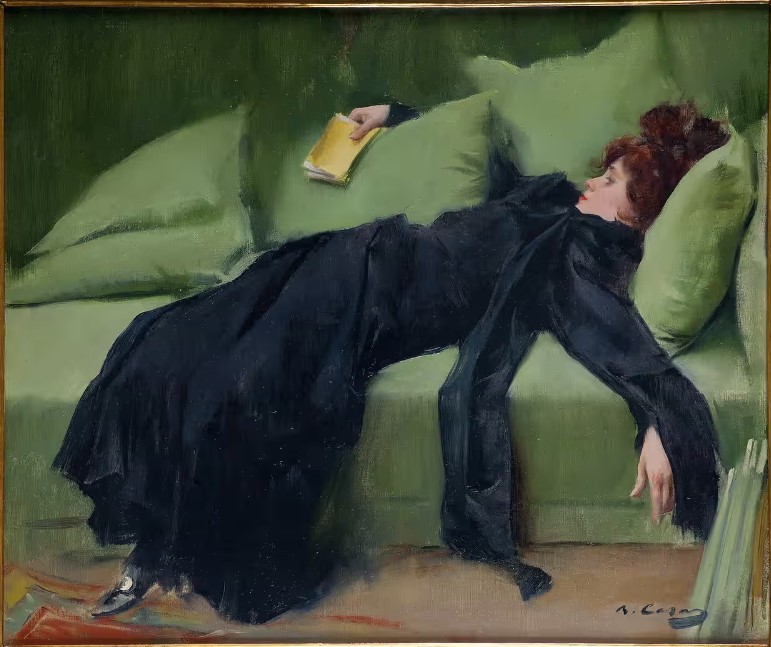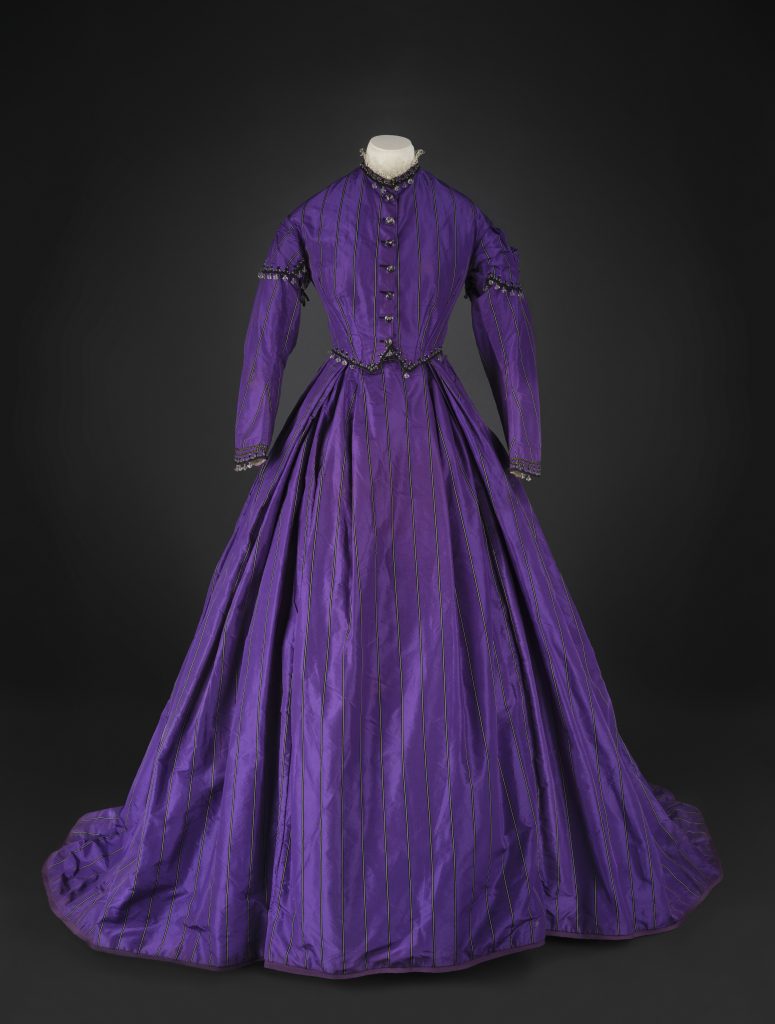Colour Revolution
Colour Revolution, the Ashmolean’s autumn exhibition, presents a dazzling version of the Victorian world, surprisingly one of the most colourful periods in history. The exhibition dispels the myth that the Victorian era was a dreary landscape of ‘dark satanic mills’ and cities choked with smog. Instead, it shows how developments in art, science and technology resulted in an explosion of colour that was embraced by artists, designers and regular people of the 19th century. The exhibition reveals a spectacular and flamboyant array of artworks, costume and design that sprung from this ‘colour revolution’. It features 140 objects from international collections ranging from Ruskin’s exquisite studies, Turner and Whistler’s experiments with colour harmony, and Morris & Co.’s elaborate designs, to fashion, jewellery and homeware that enlivened the streets and homes of Victorian Britain and Europe.
Underlined = objects and artists on display
The exhibition opens with an evocative object, encapsulating our dark preconceptions of the period: Queen Victoria’s mourning dress. Victoria herself has skewed our view of Victorian Britain with the 40 years she spent in black following Prince Albert’s death in 1861. But examples of Victorian fashion show people of the 19th century embracing the products of the Industrial Revolution, no more so than new aniline dyes. While the coal industry blackened Britain’s landscape, aniline, a by-product of coal-tar, introduced a rainbow of possibilities to Victorian wardrobes. On display will be a purple dress, crinoline and shoes dyed with the first aniline colour, Mauvine, all retaining their shocking brilliance. As production increased, the price of dyes reduced, making bright colours available to the masses. Racy dyed stockings and underwear were available to working class women – for better or worse: striped socks left striped rashes on women’s legs from toxic anilines. Undeterred, men too took advantage of the new possibilities. While formalwear and tailoring grew more conservative over the 19th century, within the confines of their own homes, men indulged in colourful smoking jackets and slippers.
Although pigments had been manufactured for thousands of years, the term ‘synthetic’ is synonymous with the 19th century because of the scale and advances of chemical technology. It was an 18-year-old chemistry student, William Henry Perkin (1838-1907) who discovered Mauvine in 1856. This encouraged chemists across Europe to find more synthetic colours. In 1867 Perkin succeeded in making alizarin, the active colorant of madder root, a traditional vegetable dye for reds, pinks and browns. Soon new anilines were being used to print postage stamps, make inks, pigments, paints, to colour paper and even food.
Such scientific advances were celebrated in one of the most important cultural events of the 19th century, the International Exhibition of 1862. It brought together examples of British, colonial and scientific products under one roof and it was the first time synthetic anilines were shown to an international audience. Two of the most fashionable aniline colours on display, vivid pinks – Magenta and Solferino – had been named after recent French victories over Austria in the 1859 Second Italian War of Independence.
The Ashmolean’s extraordinarily colourful Great Bookcase (1859–62) was the centrepiece of the Exhibition’s Medieval Court. At three meters high, the bookcase echoes the polychrome porch of a Gothic cathedral, although its style is more eclectic. Designed by the architect William Burges (1827–81), it was painted by thirteen promising young artists, including Edward Burne-Jones (1833–98) and Dante Gabriel Rossetti (1828-82). Despite their enthusiastic nostalgia, analyses show that Burges and the artists used contemporary materials including aniline green.
Revivalist and Pre-Raphaelite artists were working in the context of rapid scientific progress and the popularisation of new scientific ideas by figures like Charles Darwin (1809-82). Darwin’s concept of natural selection and the use of colour in the animal kingdom led to particularly gruesome Victorian appetites for two of nature’s most beautiful animals, beetles and hummingbirds. Unlike the feathers of a peacock, whole bird and beetle bodies were incorporated into Victorian fashion and jewellery. Jeweller, Harry Emmanuel created coveted designs including a Hummingbird necklace (1865) made of seven decapitated emerald and ruby-topaz birds. Such was the hummingbird craze that during one week in 1888, 400,000 ‘skins’ were auctioned; the following week a mere 370,000. In 1884 the Portuguese ambassador to London presented Foreign Secretary Lord Granville with a piece of jewellery made of the bodies of 46 iridescent green South American weevils. Granville had these mounted on a tiara and necklace (1885) for his wife.
Colourful fashion had a human cost too: in 1862 a factory girl making artificial flowers for women’s headdresses died from poisoning. She was said to have vomited green slime and had green tinged eyeballs. The killer was the main ingredient of the new green dye – arsenic. The incident was even reported in the USA prompting a review of the use of green in fashion and homeware. Green wallpaper became known as ‘walls of death’.
Scandals such as this and the ever-growing use of colour in popular culture prompted discussions on colour theory and different colours’ moral qualities. The exhibition will show artists who had famously different attitudes. John Ruskin (1819–1900) believed artists should stick to the God-given colours of nature. James Abbott McNeill Whistler (1834–1903) disagreed entirely and followed a philosophy of ‘colour for colour’s sake’. His extravagant use of colour was made easier by the invention of collapsible metal paint tubes.
Certain ‘unnatural’ colours were embraced by the ‘Decadent’ movement – such as the dyed-green carnation sported by Oscar Wilde. Another Decadent favourite was yellow, epitomised by a series of saucy French novels which had distinctive yellow covers. The young woman, collapsed on a sofa in Ramon Casas (1866-1932) tour de force of green (A Decadent young woman, After the dance, 1899), is shown holding one of these risqué books. Seizing on the sexy connotations, the avant-garde periodical, The Yellow Book appeared in London in 1894. Its bright yellow cover was designed by Aubrey Beardsley (1872-98). Uncompromisingly stylish and ready to push boundaries, The Yellow Book came to define the decade as ‘the Yellow Nineties’.
No exhibition on Victorian colour-culture can omit the revolutionary impact of photography and electricity. Some of the first innovators were women. Colour Revolution features one of the earliest colour reproduction techniques, cyanotypes, made by Anna Atkins (1799-1871), who used the process to create ethereally beautiful ‘photograms’ (photos made without a camera) of British algae, published in instalments from 1843-53. The exhibition closes with another pioneer, The Electric Fairy: Loïe Fuller. Once an unknown vaudeville performer from Illinois, Fuller (1862–1928) became an overnight sensation in 1892 when she premiered her modernist ‘Serpentine Dance’ at the famous Folies Bergère in Paris. Colour was central to her performances. Her voluminous costumes were made using dozens of metres of diaphanous white silk, with concealed cane rods to extend the sleeves. Enhancing the spectacle were the jewel-like colours of electric lights projecting onto the swirling silk against an otherwise darkened stage. The exhibition will show a recreation of the performance using a Victorian illusion device, a Pepper’s Ghost.
Mr Matthew Winterbottom, Curator of Sculpture and Decorative Arts and Exhibition Curator, Ashmolean Museum, says: ‘This exhibition aims to be a joyous and surprising tour through a period of history that has been misunderstood as bleak or black and white. The Victorian colour revolution made a radical impact on the lives of everyday people throughout Europe and beyond; and this is a chance to see some the 19th century’s most colourful and spectacular works of art, fashion and design.’
Images:
Ramon Casas painting: © Museu de Montserrat
Stockings: Fashion Museum Bath, photography © Ashmolean Museum, University of Oxford
Purple dress: Manchester Art Gallery, photography © Ashmolean Museum, University of Oxford


